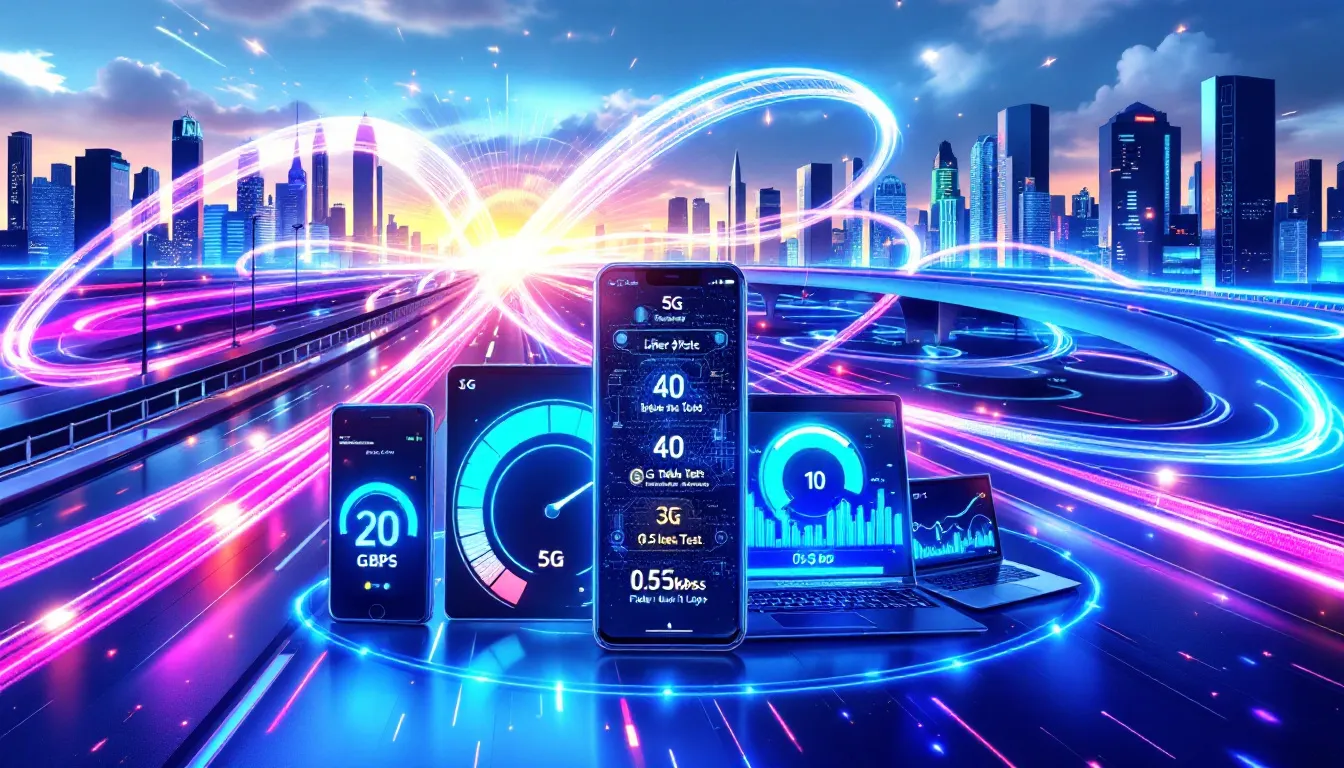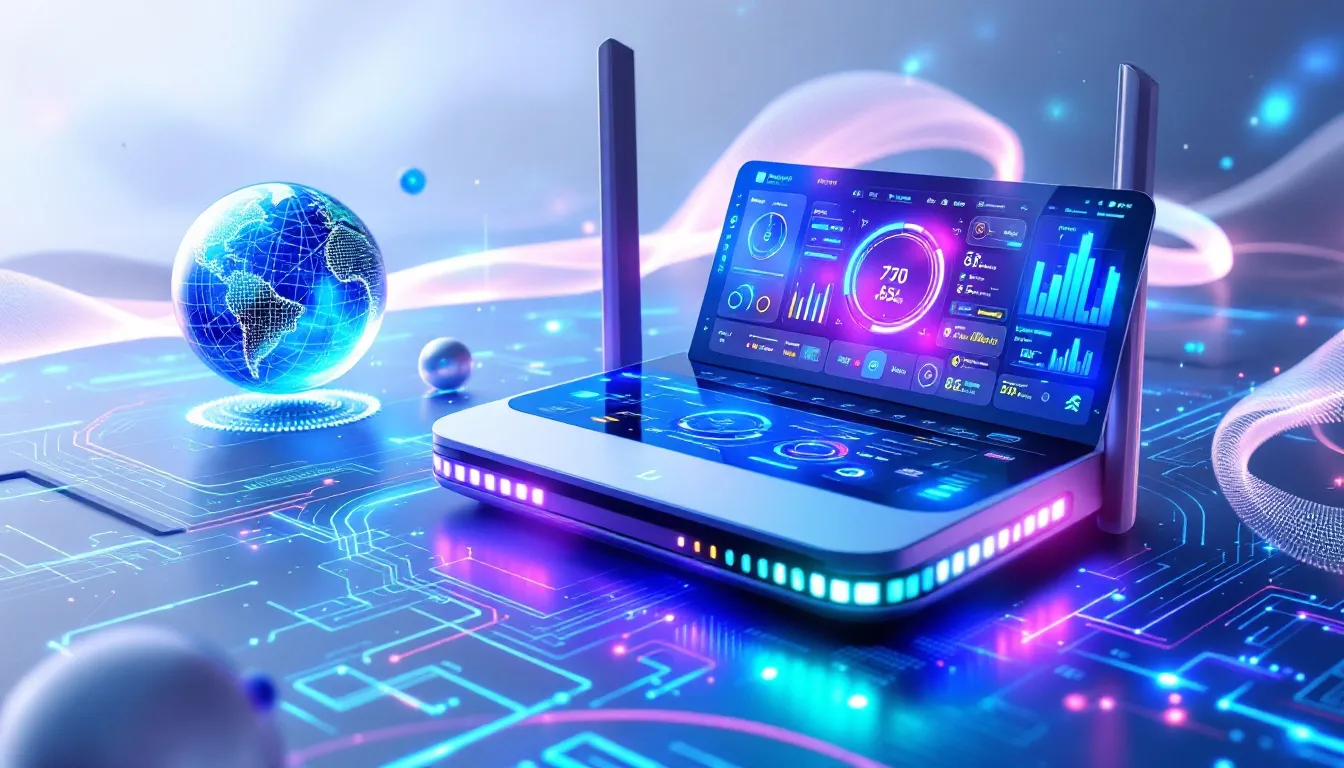Curious about your internet speed? In this article, we explain what internet speed is, how to measure it, and ways to make it faster.
Key Takeaways
Internet speed is measured in Mbps and is key for activities like streaming and gaming. Download speed is crucial for receiving data, while upload speed is important for sending data.
Factors like your connection type, network congestion, and physical obstructions can impact your internet speed. Wired connections typically offer better performance than Wi-Fi.
Regularly running speed tests can help you monitor your connection and identify issues. If speeds are consistently low, consider contacting your ISP for potential throttling or plan upgrades.
Understanding Internet Speed

Internet speed is essentially how fast data travels to and from your device. It’s measured in megabits per second (Mbps), and this measurement is crucial because it determines how quickly you can perform various online activities. Whether you’re streaming movies, gaming, or just browsing, your internet speed plays a significant role in your experience.
To get a complete picture, we need to break down internet speed into two main components: download speed and upload speed. Each serves different purposes and impacts different activities.
Download speed vs. Upload speed
Download speed is the rate at which data is received from the internet. Activities like streaming videos, loading websites, and downloading large files all rely on download speed. For instance, if you’re trying to binge-watch a series, a higher download speed will ensure that episodes load quickly and play smoothly. Most internet service plans prioritize higher download speeds because these activities are more common.
On the flip side, upload speed indicates how quickly you can send data to the internet. This is particularly important for tasks like uploading files, video conferencing, and online gaming. If you’ve ever experienced lag during a video call or while gaming, it’s likely because your upload speed wasn’t up to par.
Understanding the difference between these two speeds can help you choose the right internet plan for your needs, ensuring you have a fast connection for both downloading and uploading data.
How much speed do you need?
The amount of speed you need depends on what you do online and how many devices are connected. For a smooth streaming experience in standard definition, a minimum of 5 Mbps is recommended, while for ultra-high definition, you might need around 25 Mbps. If you have multiple devices or users, having at least 50 Mbps can help maintain quality across activities.
Online gaming typically requires speeds of at least 3 Mbps, but what’s even more crucial is lower latency for optimal performance. Ethernet connections can significantly reduce latency compared to Wi-Fi, making them more suitable for activities like online gaming and video conferencing.
If you’re experiencing frequent buffering during video calls or streaming, it might be a sign that your current internet plan isn’t providing enough speed for your needs. Always consider your household’s usage patterns to ensure you have a fast enough connection to keep everyone happy.
Factors Affecting Internet Speed

Understanding the factors that affect your internet speed can empower you to troubleshoot and enhance your connection. Various issues can lead to slow speeds, including both external factors and personal network settings. These factors include your type of internet connection, network congestion, and physical obstructions.
Let’s dive deeper into each of these factors to see how they might be impacting your internet speed and what you can do about it.
Connection type matters
The type of internet connection you have plays a massive role in your overall connection speeds. DSL and cable are common types, but fiber-optic service (FiOS) offers significantly higher speeds, making it a more attractive option for those requiring more bandwidth.
A wired Ethernet connection can provide much higher and more consistent speeds compared to Wi-Fi, with potential speeds reaching up to 10,000 Mbps. This can minimize fluctuations and provide a more stable connection, which is especially beneficial for activities that require a lot of data, like streaming and online gaming.
Network congestion
Network congestion can significantly affect your internet speed, especially during peak hours when many users are online simultaneously. This is often the case in densely populated areas where multiple households share the same bandwidth.
Internet providers may also throttle connections based on specific types of traffic, such as streaming or gaming, to manage overall network congestion. Regularly monitoring your internet speed can help you determine if your current plan is adequate for your needs and if an upgrade might be necessary.
Physical obstructions and signal interference
Physical barriers like walls and furniture can severely impact your Wi-Fi signal strength, leading to slower speeds. Materials such as concrete and metal are particularly notorious for blocking Wi-Fi signals, reducing your connectivity and speed.
To improve your signal strength, try to place your router in a central, open location in your home. This can help minimize the interference caused by physical obstructions and ensure a more consistent internet speed throughout your living space.
Testing Your Internet Speed

Running a speed test is essential for understanding your internet speed and ensuring you get the service you pay for. Regularly running speed tests helps you track any fluctuations in your internet speed and identify potential issues.
In the next sections, we’ll guide you through the process of running a speed test and interpreting the results, so you can get a clear picture of your internet connection’s performance.
Running a speed test
To run a speed test, you can visit a reliable speed test website and click on the ‘Start Test’ button. Various online tools are available for performing speed tests, each offering different insights. Comparing results from multiple tests provides a more comprehensive view of your internet connection’s performance.
Selecting the right online speed test tool ensures you get the most accurate insights into your connection speed and performance. This will help you understand if you’re getting the speeds you’re paying for and if there are any issues that need addressing through internet speed tests.
Interpreting speed test results
Speed tests assess how fast data is reaching the device that is conducting the test. They provide insights into the performance of the internet connection. Device speed is the speed that reaches an individual device, whereas plan speed is the overall speed provided by the ISP. Results might be lower than expected due to factors outside the provider’s control, like WiFi conditions and device capabilities.
Using a VPN can help determine if your internet speeds are being intentionally slowed by your ISP, as it can bypass throttling during speed tests.
Improving Your Internet Speed

Improving your internet speed may require a combination of tactics. Limiting the number of devices and managing their online time can free up bandwidth. Restarting your modem and router can resolve connection issues and improve speed.
Next, we’ll explore optimizing your router’s settings, repositioning or upgrading your router, and managing connected devices to enhance your internet performance.
Optimize your router’s settings
Adjusting your router’s settings can significantly improve your internet speed. The Quality of Service (QoS) setting prioritizes bandwidth to specific devices, ensuring that critical devices receive the necessary speed.
Securing your network is also essential to prevent unauthorized access, which can slow down your speed. Regularly updating your router firmware can resolve existing bugs and improve performance.
Repositioning and upgrading your router
Placing your router in an open area can help improve signal strength and reduce interference. Ideally, place it in a central location to maximize coverage and minimize dead zones.
Installing a mesh network can also enhance coverage and eliminate dead zones. Mesh networks are easy to set up, often through a dedicated mobile application, and can scale by adding additional nodes without requiring major upgrades to existing hardware.
Managing connected devices
Disconnecting unused devices connected and other devices can free up bandwidth and improve the overall internet speed for all your devices. Setting device priorities in your router can help ensure that more important devices receive adequate bandwidth.
Prioritizing devices that need high-speed access can enhance the overall internet experience, ensuring that essential activities like video calls and streaming are not interrupted.
Advanced Solutions for Faster Internet

For those with demanding connectivity needs, advanced solutions can significantly enhance internet performance. Utilizing wired connections and mesh networks can provide more stable and faster internet speeds.
Let’s delve into using Ethernet over Wi-Fi and setting up a mesh network for improved internet speed.
Using Ethernet over Wi-Fi
Using an Ethernet connection instead of Wi-Fi can significantly improve performance. Ethernet connections free up Wi-Fi bandwidth, allowing for better performance of both wired and wireless devices.
This setup is especially beneficial for activities that require high data transfer rates, such as online gaming and streaming, providing a more stable and faster connection.
Setting up a mesh network
Mesh networks are designed to cover larger areas and eliminate Wi-Fi dead zones by using multiple interconnected nodes. These nodes work together to provide seamless coverage, effectively eliminating dead zones in larger homes.
One of the benefits of mesh networks is their ability to automatically reroute smart home devices to the nearest node with a better signal, maintaining strong Wi-Fi coverage throughout your home.
When to Contact Your Internet Provider
There are times when despite all your efforts, your internet speed remains subpar. Running a speed test can indicate whether you’re receiving the internet speeds you’re paying for. If not, it might be time to contact your internet provider.
We’ll discuss checking for ISP throttling and when to consider upgrading your internet plan for better speeds.
Checking for ISP throttling
ISP throttling is the intentional slowing down of internet speeds by your provider based on user behavior or overall network congestion. You can identify potential throttling by using a VPN and comparing speeds with and without the VPN connection. If your speeds improve significantly while using a VPN, it’s likely that your ISP is throttling your connection.
If you detect throttling through speed tests, consider discussing the issue with your ISP. They might offer alternative plans or solutions to address the issue.
Upgrading your internet plan
When your current plan does not provide enough speed for your devices, it might be time to consider an upgrade. High-bandwidth activities like online gaming, streaming, and multiple connected devices can demand more speed than your current plan offers.
Contact your internet provider to explore faster plan options. They can help you choose a plan that meets your needs, ensuring you get the fast connection necessary for all your online activities.
Summary
In summary, maximizing your internet speed involves understanding the basics of internet speed, identifying factors that affect it, and taking steps to improve it. By running regular speed tests, optimizing your router settings, managing connected devices, and considering advanced solutions like Ethernet connections and mesh networks, you can significantly enhance your internet performance.
Remember, if all else fails, contacting your internet provider to discuss potential throttling issues or upgrading your plan can make a world of difference. With these tips and tricks, you’re well on your way to enjoying a faster, more reliable internet connection.
Frequently Asked Questions
How can I check if my internet speed is being throttled?
To check if your internet speed is being throttled, try using a VPN to see if your speeds increase when connected. If they do, your ISP might be slowing you down.
What is the difference between download speed and upload speed?
Download speed is how fast you can receive data, which is key for streaming and browsing, while upload speed measures how quickly you can send data, important for video calls and file uploads. So, if you’re sharing files often, pay attention to that upload speed!
How much internet speed do I need for streaming and gaming?
You’ll want at least 25 Mbps for smooth streaming in ultra-high definition and around 3 Mbps for gaming, but faster speeds are better for a lag-free experience. So, shooting for 25 Mbps or higher is a solid bet!
What factors can affect my internet speed?
Your internet speed can be impacted by your connection type, peak hour congestion, physical obstacles like walls, and interference from other devices. So, if you’re experiencing slow speeds, it might be worth checking those factors!
How can I improve my internet speed?
To boost your internet speed, try optimizing your router settings, repositioning it for better coverage, and using an Ethernet cable instead of Wi-Fi. Managing the number of connected devices can also help speed things up!